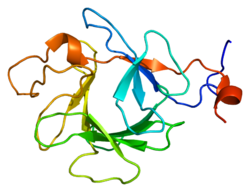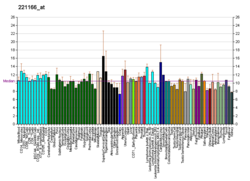Fibroblast growth factor 23(FGF-23) is aproteinand member of thefibroblast growth factor(FGF) family which participates in the regulation ofphosphatein plasma andvitamin Dmetabolism. In humans it isencodedby theFGF23gene.FGF-23 decreases reabsorption of phosphate in the kidney. Mutations inFGF23can lead to its increased activity, resulting inautosomal dominant hypophosphatemic rickets.
Description
editFibroblast growth factor 23 (FGF23) is aproteinwhich in humans is encoded by theFGF23gene.[5]FGF23 is a member of thefibroblast growth factor(FGF) family which participates inphosphateandvitamin Dmetabolism and regulation.[6][7]
Function
editFGF23´s main function is to regulate the phosphate concentration in plasma. It does this by decreasing reabsorption of phosphate in the kidney, which means phosphate is excreted in urine. FGF23 is secreted byosteocytesin response to increasedcalcitrioland phosphate.[8][9][10][11]FGF23 acts on the kidneys by decreasing the expression of NPT2, asodium-phosphate cotransporterin theproximal tubule.[12]
FGF23 may also suppress1-alpha-hydroxylase,reducing its ability to activatevitamin Dand subsequently impairing calcium absorption.[7][13]
Genetics
editIn humans FGF23 is encoded by theFGF23gene,which is located onchromosome 12and is composed of threeexons.The gene was identified by its mutations associated withautosomal dominant hypophosphatemic rickets.[14]
Clinical significance
editMutations inFGF23,which render the protein resistant to proteolytic cleavage, lead to its increased activity and torenalphosphate loss, in the human diseaseautosomal dominant hypophosphatemic rickets.
FGF23 can also be overproduced by some types oftumors,such as thebenignmesenchymalneoplasmphosphaturic mesenchymal tumorcausingtumor-induced osteomalacia,aparaneoplastic syndrome.[15][16]
Loss of FGF23 activity is thought to lead to increased phosphate levels and the clinical syndrome of familial tumorcalcinosis.Mice lacking either FGF23 or theklothoenzyme age prematurely due tohyperphosphatemia.[17]
Over-expression of FGF23 has been associated with cardiovascular disease in chronic kidney disease including cardiomyocyte hypertrophy, vascular calcification, stroke, and endothelial dysfunction.[18]
FGF23 expression and cleavage is promoted byiron deficiencyand inflammation.[19]
FGF23 is associated with at least 7 non-nutritional diseases of hypophosphatemia: aside from autosomal dominant hypophosphatemic rickets,X-linked hypophosphatemia,autosomal recessive hypophosphatemic rickets type 1, 2, and 3,Tumor-induced osteomalaciaand Hypophosphatemic rickets with hypercalciuria.[18]
History
editPrior to its discovery in 2000, it was hypothesized that a protein existed which performed the functions subsequently shown for FGF23. This putative protein was known as phosphatonin.[20]Several types of effects were described including impairment of sodium dependent phosphate transport in both intestinal and renal brush border membrane vesicles, inhibition of production of calcitriol, stimulation of breakdown of calcitriol, and inhibition of production/secretion of parathyroid hormone.
References
edit- ^abcGRCh38: Ensembl release 89: ENSG00000118972–Ensembl,May 2017
- ^abcGRCm38: Ensembl release 89: ENSMUSG00000000182–Ensembl,May 2017
- ^"Human PubMed Reference:".National Center for Biotechnology Information, U.S. National Library of Medicine.
- ^"Mouse PubMed Reference:".National Center for Biotechnology Information, U.S. National Library of Medicine.
- ^Yamashita T, Yoshioka M, Itoh N (October 2000). "Identification of a novel fibroblast growth factor, FGF-23, preferentially expressed in the ventrolateral thalamic nucleus of the brain".Biochemical and Biophysical Research Communications.277(2): 494–498.doi:10.1006/bbrc.2000.3696.PMID11032749.
- ^Fukumoto S (2008)."Physiological regulation and disorders of phosphate metabolism--pivotal role of fibroblast growth factor 23".Internal Medicine.47(5): 337–343.doi:10.2169/internalmedicine.47.0730.PMID18310961.
- ^abPerwad F, Zhang MY, Tenenhouse HS, Portale AA (November 2007). "Fibroblast growth factor 23 impairs phosphorus and vitamin D metabolism in vivo and suppresses 25-hydroxyvitamin D-1alpha-hydroxylase expression in vitro".American Journal of Physiology. Renal Physiology.293(5): F1577–F1583.doi:10.1152/ajprenal.00463.2006.PMID17699549.S2CID20559055.
- ^Dance A (23 February 2022)."Fun facts about bones: More than just scaffolding".Knowable Magazine.doi:10.1146/knowable-022222-1.S2CID247095495.Retrieved8 March2022.
- ^Robling AG, Bonewald LF (February 2020)."The Osteocyte: New Insights".Annual Review of Physiology.82(1): 485–506.doi:10.1146/annurev-physiol-021119-034332.PMC8274561.PMID32040934.
- ^Cha SK, Ortega B, Kurosu H, Rosenblatt KP, Kuro-O M, Huang CL (July 2008)."Removal of sialic acid involving Klotho causes cell-surface retention of TRPV5 channel via binding to galectin-1".Proceedings of the National Academy of Sciences of the United States of America.105(28): 9805–9810.Bibcode:2008PNAS..105.9805C.doi:10.1073/pnas.0803223105.PMC2474477.PMID18606998.
- ^Brown RB, Razzaque MS (January 2018). "Chapter 31 - Endocrine Regulation of Phosphate Homeostasis". In Singh AK, Williams GH (eds.).Textbook of Nephro-Endocrinology(Second ed.). Academic Press. pp. 539–548.doi:10.1016/b978-0-12-803247-3.00032-5.hdl:10012/15679.ISBN978-0-12-803247-3.S2CID102827267.
- ^Jüppner H (April 2011)."Phosphate and FGF-23".Kidney International. Supplement.79(121): S24–S27.doi:10.1038/ki.2011.27.PMC3257051.PMID21346724.
- ^Rodríguez-Ortiz ME, Rodríguez M (2015)."FGF23 as a calciotropic hormone".F1000Research.4:1472.doi:10.12688/f1000research.7189.1.PMC4815615.PMID27081473.
- ^"Entrez Gene: FGF23 fibroblast growth factor 23".
- ^Zadik Y, Nitzan DW (February 2012). "Tumor induced osteomalacia: a forgotten paraneoplastic syndrome?".Oral Oncology.48(2): e9-10.doi:10.1016/j.oraloncology.2011.09.011.PMID21985764.
- ^Green D, Mohorianu I, Piec I, Turner J, Beadsmoore C, Toms A, et al. (December 2017)."MicroRNA expression in a phosphaturic mesenchymal tumour".Bone Reports.7:63–69.doi:10.1016/j.bonr.2017.09.001.PMC5596358.PMID28932769.
- ^Huang CL (May 2010)."Regulation of ion channels by secreted Klotho: mechanisms and implications".Kidney International.77(10): 855–860.doi:10.1038/ki.2010.73.PMID20375979.
- ^abBeck-Nielsen SS, Mughal Z, Haffner D, Nilsson O, Levtchenko E, Ariceta G, et al. (February 2019)."FGF23 and its role in X-linked hypophosphatemia-related morbidity".Orphanet Journal of Rare Diseases.14(1): 58.doi:10.1186/s13023-019-1014-8.PMC6390548.PMID30808384.
- ^David V, Martin A, Isakova T, Spaulding C, Qi L, Ramirez V, et al. (January 2016)."Inflammation and functional iron deficiency regulate fibroblast growth factor 23 production".Kidney International.89(1): 135–146.doi:10.1038/ki.2015.290.PMC4854810.PMID26535997.
- ^Strewler GJ (May 2001)."FGF23, hypophosphatemia, and rickets: has phosphatonin been found?".Proceedings of the National Academy of Sciences of the United States of America.98(11): 5945–5946.doi:10.1073/pnas.11154898.PMC33399.PMID11371627.
Further reading
edit- Kiela PR, Ghishan FK (January 2009)."Recent advances in the renal-skeletal-gut axis that controls phosphate homeostasis".Laboratory Investigation; A Journal of Technical Methods and Pathology.89(1): 7–14.doi:10.1038/labinvest.2008.114.PMC4292907.PMID19029978.
- Silve C, Beck L (June 2002). "Is FGF23 the long sought after phosphaturic factor phosphatonin?".Nephrology, Dialysis, Transplantation.17(6): 958–961.doi:10.1093/ndt/17.6.958.PMID12032180.
- Quarles LD (July 2003). "FGF23, PHEX, and MEPE regulation of phosphate homeostasis and skeletal mineralization".American Journal of Physiology. Endocrinology and Metabolism.285(1): E1–E9.doi:10.1152/ajpendo.00016.2003.PMID12791601.
- Fukagawa M, Nii-Kono T, Kazama JJ (July 2005). "Role of fibroblast growth factor 23 in health and in chronic kidney disease".Current Opinion in Nephrology and Hypertension.14(4): 325–329.doi:10.1097/01.mnh.0000172717.49476.80.PMID15930999.S2CID23555353.
- Imel EA, Econs MJ (September 2005). "Fibroblast growth factor 23: roles in health and disease".Journal of the American Society of Nephrology.16(9): 2565–2575.doi:10.1681/ASN.2005050573.PMID16033853.S2CID8612881.
- Liu S, Quarles LD (June 2007)."How fibroblast growth factor 23 works".Journal of the American Society of Nephrology.18(6): 1637–1647.doi:10.1681/ASN.2007010068.PMID17494882.
- White KE, Evans WE, O'Riordan JL, Speer MC, Econs MJ, Lorenz-Depiereux B, et al. (ADHR Consortium) (November 2000). "Autosomal dominant hypophosphataemic rickets is associated with mutations in FGF23".Nature Genetics.26(3): 345–348.doi:10.1038/81664.PMID11062477.S2CID38870810.
- White KE, Jonsson KB, Carn G, Hampson G, Spector TD, Mannstadt M, et al. (February 2001)."The autosomal dominant hypophosphatemic rickets (ADHR) gene is a secreted polypeptide overexpressed by tumors that cause phosphate wasting".The Journal of Clinical Endocrinology and Metabolism.86(2): 497–500.doi:10.1210/jcem.86.2.7408.PMID11157998.
- Shimada T, Mizutani S, Muto T, Yoneya T, Hino R, Takeda S, et al. (May 2001)."Cloning and characterization of FGF23 as a causative factor of tumor-induced osteomalacia".Proceedings of the National Academy of Sciences of the United States of America.98(11): 6500–6505.Bibcode:2001PNAS...98.6500S.doi:10.1073/pnas.101545198.PMC33497.PMID11344269.
- Bowe AE, Finnegan R, Jan de Beur SM, Cho J, Levine MA, Kumar R, et al. (June 2001). "FGF-23 inhibits renal tubular phosphate transport and is a PHEX substrate".Biochemical and Biophysical Research Communications.284(4): 977–981.doi:10.1006/bbrc.2001.5084.PMID11409890.
- White KE, Carn G, Lorenz-Depiereux B, Benet-Pages A, Strom TM, Econs MJ (December 2001)."Autosomal-dominant hypophosphatemic rickets (ADHR) mutations stabilize FGF-23".Kidney International.60(6): 2079–2086.doi:10.1046/j.1523-1755.2001.00064.x.PMID11737582.
- Kruse K, Woelfel D, Strom TM (2002). "Loss of renal phosphate wasting in a child with autosomal dominant hypophosphatemic rickets caused by a FGF23 mutation".Hormone Research.55(6): 305–308.doi:10.1159/000050018(inactive 1 November 2024).PMID11805436.S2CID46748089.
{{cite journal}}:CS1 maint: DOI inactive as of November 2024 (link) - Yamashita T, Konishi M, Miyake A, Inui K, Itoh N (August 2002)."Fibroblast growth factor (FGF)-23 inhibits renal phosphate reabsorption by activation of the mitogen-activated protein kinase pathway".The Journal of Biological Chemistry.277(31): 28265–28270.doi:10.1074/jbc.M202527200.PMID12032146.
- Saito H, Kusano K, Kinosaki M, Ito H, Hirata M, Segawa H, et al. (January 2003)."Human fibroblast growth factor-23 mutants suppress Na+-dependent phosphate co-transport activity and 1alpha,25-dihydroxyvitamin D3 production".The Journal of Biological Chemistry.278(4): 2206–2211.doi:10.1074/jbc.M207872200.PMID12419819.
- Bai XY, Miao D, Goltzman D, Karaplis AC (March 2003)."The autosomal dominant hypophosphatemic rickets R176Q mutation in fibroblast growth factor 23 resists proteolytic cleavage and enhances in vivo biological potency".The Journal of Biological Chemistry.278(11): 9843–9849.doi:10.1074/jbc.M210490200.PMID12519781.
- Larsson T, Zahradnik R, Lavigne J, Ljunggren O, Jüppner H, Jonsson KB (February 2003)."Immunohistochemical detection of FGF-23 protein in tumors that cause oncogenic osteomalacia".European Journal of Endocrinology.148(2): 269–276.doi:10.1530/eje.0.1480269.PMID12590648.
- Campos M, Couture C, Hirata IY, Juliano MA, Loisel TP, Crine P, et al. (July 2003)."Human recombinant endopeptidase PHEX has a strict S1' specificity for acidic residues and cleaves peptides derived from fibroblast growth factor-23 and matrix extracellular phosphoglycoprotein".The Biochemical Journal.373(Pt 1): 271–279.doi:10.1042/BJ20030287.PMC1223479.PMID12678920.
This article incorporates text from theUnited States National Library of Medicine,which is in thepublic domain.





